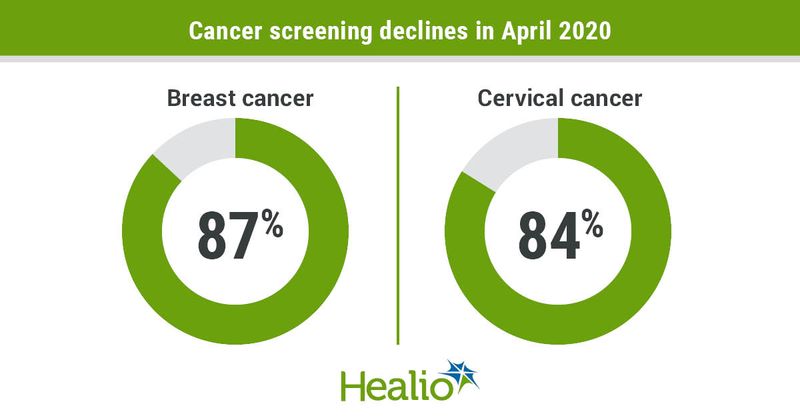CDC reports 80% declines in breast, cervical cancer screenings during start of pandemic
Click Here to Manage Email Alerts
Breast cancer and cervical cancer screenings declined sharply during the early part of the COVID-19 pandemic, according to CDC data released today.
An analysis of data form the National Breast and Cervical Cancer Early Detection Program — which provides cancer screenings to women with low income and inadequate health insurance — showed an 87% decline in breast cancer screening and an 84% decline in cervical cancer screening in April 2020 compared with the previous 5-year averages for that month.

The decline coincided with reduced screening access and a shift in the health care community’s priorities during the initial surge of COVID-19 cases. Researchers identified screening site closures, public health guidance that urged individuals to stay home and widespread fear among Americans about contracting the novel coronavirus as potential factors.
“This study highlights a decline in cancer screening among women of racial and ethnic minority groups with low incomes when their access to medical services decreased at the beginning of the pandemic,” researcher Amy DeGroff, PhD, MPH, CDC health scientist, said in a press release. “They reinforce the need to safely maintain routine health care services during the pandemic, especially when the health care environment meets COVID-19 safety guidelines.”
DeGroff and colleagues assessed COVID-19’s effects on the early detection program’s screening rates from January to June 2020.
The extent of screening declines varied by region, race/ethnicity, and rural vs. more urban settings.
Results showed declines in breast cancer screenings ranged from 84% among Hispanic women to 98% among American Indian/Alaskan Native women. Declines in cervical cancer screening ranged from 82% among Black women to 92% among Asian Pacific Islander women.
In April 2020, breast cancer screenings declined by 86% in metro areas, 88% in urban areas and 89% in rural areas compared with 5-year averages. Cervical cancer screenings declined by 85% in metro areas, 77% in urban areas and 82% in rural areas.
Although screening volume had started to recover by June 2020, researchers suggested the declines observed early in the pandemic may result in delayed diagnosis, potentially contributing to poorer outcomes and exacerbating disparities in cancer outcomes among populations that more typically experience health inequities.
“CDC encourages health care professionals to help minimize delays in testing by continuing routine cancer screening for women having symptoms or at high risk for breast or cervical cancer,” DeGroff said. “The early detection program can help women overcome barriers to health equity by educating them about the importance of routine screening, addressing their concerns about COVID-19 transmission, and helping them to safely access screening through interventions like patient navigation.”
